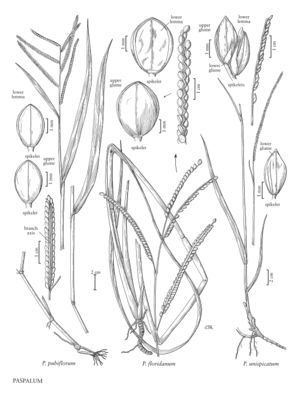Difference between revisions of "Paspalum floridanum"
FNA>Volume Importer |
imported>Volume Importer |
||
| (6 intermediate revisions by 2 users not shown) | |||
| Line 4: | Line 4: | ||
|publications= | |publications= | ||
|common_names=Florida paspalum | |common_names=Florida paspalum | ||
| + | |special_status={{Treatment/ID/Special_status | ||
| + | |code=E | ||
| + | |label=Endemic | ||
| + | }} | ||
|basionyms= | |basionyms= | ||
|synonyms={{Treatment/ID/Synonym | |synonyms={{Treatment/ID/Synonym | ||
|name=Paspalum longicilium | |name=Paspalum longicilium | ||
| − | |authority= | + | |authority= |
| + | |rank=species | ||
}} {{Treatment/ID/Synonym | }} {{Treatment/ID/Synonym | ||
|name=Paspalum floridanum var. glabratum | |name=Paspalum floridanum var. glabratum | ||
| − | |authority= | + | |authority= |
| + | |rank=variety | ||
}} {{Treatment/ID/Synonym | }} {{Treatment/ID/Synonym | ||
|name=Paspalum difforme | |name=Paspalum difforme | ||
| − | |authority= | + | |authority= |
| + | |rank=species | ||
}} | }} | ||
|hierarchy=Poaceae;Poaceae subfam. Panicoideae;Poaceae tribe Paniceae;Paspalum;Paspalum floridanum | |hierarchy=Poaceae;Poaceae subfam. Panicoideae;Poaceae tribe Paniceae;Paspalum;Paspalum floridanum | ||
| Line 25: | Line 32: | ||
-->{{Treatment/Body | -->{{Treatment/Body | ||
| − | |distribution=Md.;Kans.;Okla.;Miss.;Tex.;La.;Pa.;Mo.;Del.;Ala.;D.C;Tenn.;N.C.;S.C.;Va.;Ark.;Ill.;Ga.;Ind.;Ky.;N.J.;Fla.;Ohio | + | |distribution=Md.;Kans.;Okla.;Miss.;Tex.;La.;Pa.;Mo.;Del.;Ala.;D.C.;Tenn.;N.C.;S.C.;Va.;Ark.;Ill.;Ga.;Ind.;Ky.;N.J.;Fla.;Ohio |
|discussion=<p><i>Paspalum floridanum</i> grows along the edges of forests, flatwoods, and pinewoods and in open areas. It is a frequent component of dry-mesic soils in longleaf pine-oak-grass ecosystems, and is restricted to the eastern United States.</p> | |discussion=<p><i>Paspalum floridanum</i> grows along the edges of forests, flatwoods, and pinewoods and in open areas. It is a frequent component of dry-mesic soils in longleaf pine-oak-grass ecosystems, and is restricted to the eastern United States.</p> | ||
|tables= | |tables= | ||
| Line 35: | Line 42: | ||
-->{{#Taxon: | -->{{#Taxon: | ||
name=Paspalum floridanum | name=Paspalum floridanum | ||
| − | |||
|authority=Michx. | |authority=Michx. | ||
|rank=species | |rank=species | ||
| Line 42: | Line 48: | ||
|basionyms= | |basionyms= | ||
|family=Poaceae | |family=Poaceae | ||
| − | |distribution=Md.;Kans.;Okla.;Miss.;Tex.;La.;Pa.;Mo.;Del.;Ala.;D.C;Tenn.;N.C.;S.C.;Va.;Ark.;Ill.;Ga.;Ind.;Ky.;N.J.;Fla.;Ohio | + | |illustrator=Linda A. Vorobik;Cindy Roché |
| + | |illustration copyright=Utah State University | ||
| + | |distribution=Md.;Kans.;Okla.;Miss.;Tex.;La.;Pa.;Mo.;Del.;Ala.;D.C.;Tenn.;N.C.;S.C.;Va.;Ark.;Ill.;Ga.;Ind.;Ky.;N.J.;Fla.;Ohio | ||
|reference=None | |reference=None | ||
|publication title= | |publication title= | ||
|publication year= | |publication year= | ||
| − | |special status= | + | |special status=Endemic |
| − | |source xml=https:// | + | |source xml=https://bitbucket.org/aafc-mbb/fna-data-curation/src/200273ad09963decb8fc72550212de541d86569d/coarse_grained_fna_xml/V25/V25_1493.xml |
|subfamily=Poaceae subfam. Panicoideae | |subfamily=Poaceae subfam. Panicoideae | ||
|tribe=Poaceae tribe Paniceae | |tribe=Poaceae tribe Paniceae | ||
Latest revision as of 17:57, 11 May 2021
Plants perennial; rhizomatous. Culms 80-210 cm, erect; nodes glabrous or pubescent. Sheaths glabrous or pubescent; ligules 1.2-3.3 mm; blades to 52 cm long, 3-18 mm wide, flat, glabrous or pubescent, usually densely pubescent behind the ligules. Panicles terminal, with 1-6 racemosely arranged branches; branches 3-17.9 cm, divergent to erect, terminating in a spikelet; branch axes 0.3-1.8 mm wide, glabrous, the margins scabrous. Spikelets 2.9-4.1 mm long, 1.9-3.1 mm wide, paired, imbricate, appressed to the branch axes, elliptic to suborbicular to orbicular, glabrous, stramineous. Lower glumes absent; upper glumes glabrous, 5-veined, margins entire; lower lemmas glabrous, lacking ribs over the veins, 3-veined, margins entire; upper florets golden brown. Caryopses 2.8 mm, amber. 2n = 120, 140, ca. 160-170.
Distribution
Md., Kans., Okla., Miss., Tex., La., Pa., Mo., Del., Ala., D.C., Tenn., N.C., S.C., Va., Ark., Ill., Ga., Ind., Ky., N.J., Fla., Ohio
Discussion
Paspalum floridanum grows along the edges of forests, flatwoods, and pinewoods and in open areas. It is a frequent component of dry-mesic soils in longleaf pine-oak-grass ecosystems, and is restricted to the eastern United States.
Selected References
None.
